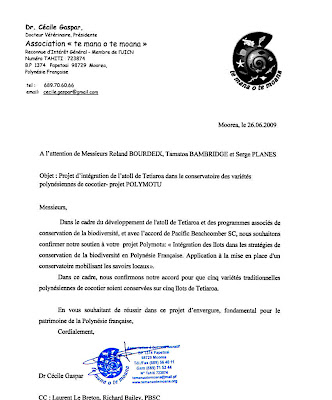 |
| Hinano Murphy and members of the Atiti'a Association |
At the beginning, they just do not believe you; and you need time and care to convince them. Anyway, I succeeded quite well in this challenge, as shown in the press releases available here.
Some of these lectures were conducted in large conference room, with more than 100 people listening, for instance at the University of French Polynesia. Some others lectures were released in small villages of remote islands, with no more than 20 people listening.
 |
| Patirita from Tatakoto Atoll |
During the conference, I presented a short movie made in Africa at the Marc Delorme Research Centre. This movie shows the technique of assisted pollination for production of coconut hybrid seednuts. In this video, the inflorescence of a Malayan Yellow Dwarf (MYD) is artificially unwrap before its natural opening; then all the spikelets containing male flowers are cut; all the remaining male flowers are remove in order to keep only the female flowers on the inflorescence. When these female flowers become mature, a mix of talk and pollen of the West African Tall (WAT) is pulverized on the inflorescence in order to obtain seednuts of the Mawa Hybrid (MYDxWAT).
o
At the end of the lecture, we had some interesting exchanges with the Polynesian sages about cultural facts regarding the coconut palm. But nothing really important was said. Hopefully, one week later, I was lucky to meet again Hinano Murphy and to get an indirect feedback regarding the reactions and feelings of the old Polynesian sages.
In fact, when watching my movie, the sages were deeply shocked by the disrespectful and brutal way the coconut palm was treated.
The legitimacy of man's direct intervention, with instruments, on plant reproduction is not accepted in all the cultures : this is a fact of society. What seems to be decisive in the assessment of the planting material is not only its agricultural value or utilization value, but also the process by which it was created, its legitimacy and its consequences.
The issue of man's legitimate action on his environment was studied by André-Georges Haudricourt (1962). Haudricourt looked at two extreme types by comparing sheep and yam, to analyse the relations that man has with domesticated beings, be they plants or animals.
In sheep rearing, as it is practised in the Mediterranean region, the contact with the domesticated being is permanent, sometimes brutal: the shepherd accompanies and directs his herd with his stick and his sheepdogs, schedules watering holes and determines the routes taken. Without man, the herd could not survive, so that man's action needs to be direct for the effect to be positive.
Yam growing (Dioscorea alata L.) as practised by the Melanesians of New Caledonia illustrates the other extreme: positive indirect action. The Melanesians are never in brutal contact with the plant. Man intervenes around the plant by constructing ridges and spacing the tubers, which are then left to grow, because direct action would be prejudicial or negative for the plant.
Haudricourt goes on to quote the work by the Chinese thinker Mencius, born around 300 years BC:
"A man, troubled to see that his rice was not growing, pulled at the stems. On returning home, the fool told his household: ‘today I am very tired, I have helped the crop to grow’. His sons ran to see his work for themselves. The stems were already dry. (…) Those who use violent means …. do like this madman who pulled up his crop. Their efforts are not only futile, they are harmful".
Haudricourt puts forward a parallel between the treatment of plants and the treatment of others. He takes the example of traditional Chinese society, emphasising that good government depends here on the virtue of the statesmen and not on its actions "just as the virtue of the land makes for the rapid growth of plantations". Man is not placed in a position of cause, otherwise the effect is negative.
In the framework of the Polymotu project, we are proposing two new designs to produce coconut seeds: the first design is adapted to small islands. The second design is adapted the mainlands with landscaping pollen barriers. In both designs, hybrids seednuts can be obtained naturally, without human intervention on the inflorescences. So it fit more closely with Polynesian tradition and the "respect due the coconut palm"... .
Reference
Haudricourt, A. G. 1962. Domestication des animaux, culture des plantes et traitement d'autrui, L’homme, Tome II, 40-50.








.jpg)



